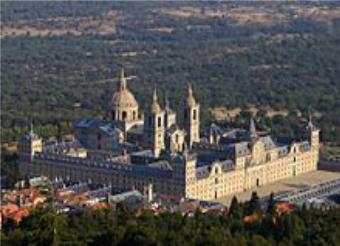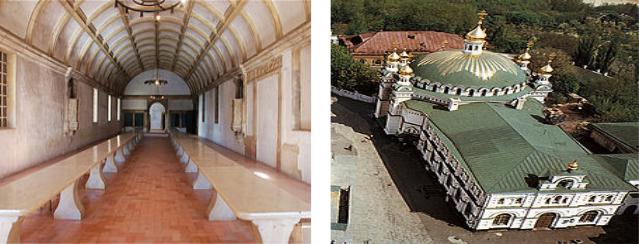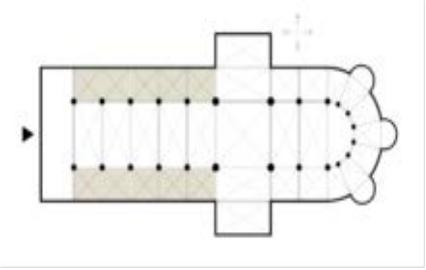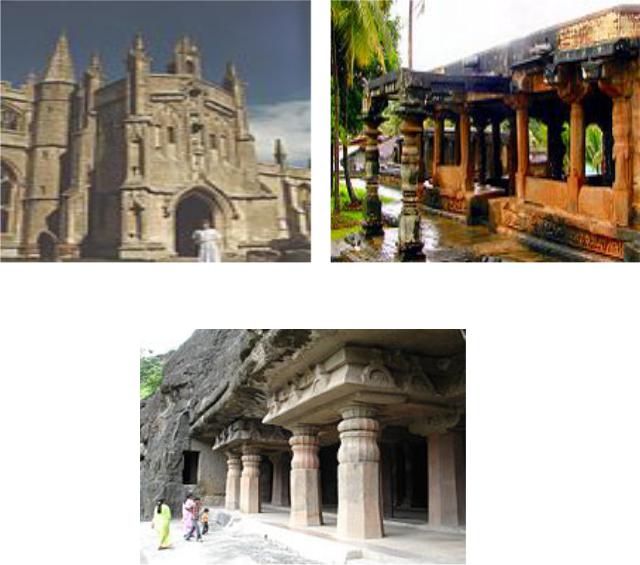
- •Введение
- •INTRODUCTION
- •Architecture as a scientific discipline
- •Cathedrals and great churches
- •A cathedral
- •Abbey
- •Belfry
- •Chapel
- •Baptistery
- •Monastery
- •Parts of religious architectural ensemble
- •CITY ARCHITECTURAL OBJECTS
- •Megalopolis
- •Street
- •Boulevard
- •Plaza
- •City block
- •Guard rail
- •Terrace
- •Race course
- •Viaduct
- •Interchange (road)
- •Town hall
- •Tower
- •Museum
- •Amphitheatre
- •Bridge
- •Causeway
- •ORNATE ARCHITECTURAL OBJECTS
- •Park
- •Pavilion
- •Grotto
- •Fountain
- •HISTORICAL ARCHITECTURAL OBJECTS
- •Fire tower
- •Kremlin
- •Fortress
- •Barn
- •Izba
- •Log house
- •Presidio
- •Redoubt
- •Bastion
- •Palace
- •Castle
- •ELEMENTS OF A CASTLE
- •RESIDENTIAL STRUCTURES
- •Villa, cottage
- •Exterior
- •Veranda
- •Roof
- •Balustrade
- •Balcony
- •Parapet
- •Portico
- •Spire
- •Facade
- •INTERIOR
- •Basement
- •Hall
- •Enfilade
- •Attic
- •Staircase
- •Gallery
- •Mezzanine
- •Storey
- •Библиографический список

Рис. 22
Parts of religious architectural ensemble |
|
Nave |
|
In Romanesque and Gothic Christian abbey, cathedral basilica and church |
|
|
И |
architecture, the nave is the main body of the church. It provides the central |
|
approach to the high altar. The term nave,Дfrom medieval Latin navis (ship), was probably suggested by the keel shape of its vaulting. The nave of a church,
whether Romanesque, Gothic or Classical,Аextends from the entry − which may
of a width comparable to theбcentral nave, the structure is sometimes said to have three naves.
have a separate vestibuleи(the narthex) − to the chancel and may be flanked by
lower side-aisles separated from the nave by an arcade. If the aisles are high and С
Задание 1. Переведите словоформы, учитывая контекст их употребления: keel, vaulting, chancel, flanked, aisles.
Задание 2. Дайте определение понятию nave по схеме, предложенной во введении. Используйте следующие модели:
The concept of …can be determined as…
The notion under review covers such points as...
The notion “…” covers such points as… The notion “…” contains such ones as…
Задание 3. Продолжите предложения:
-Nave provides the…
- If the naves are high and of a width comparable to the central nave,…
29

Задание 4. Заполните пустую графу таблицы.
Definition |
Translation |
Неф – вытянутое помещение, часть |
|
интерьера (обычно в зданиях типа |
|
базилики), ограниченное с одной или с |
|
обеих продольных сторон рядом колонн |
|
или столбов |
|
Задание 5. Опишите, какие объекты архитектуры вы видите на рис.
23, 24. Используйте следующие модели: |
|
|||
The first picture illustrates … |
|
|
|
|
We can see a…in the second picture. |
И |
|||
The buildings, we can see on the …picture, are... |
||||
The characteristic features of the object are… |
||||
The figure illustrates the… |
|
Д |
||
|
|
|
||
|
|
А |
|
|
|
б |
|
|
|
и |
|
|
|
|
С |
|
|
|
|
Рис. 23 Рис. 24
Refectory
Задание 1. Сопоставьте тексты. Дополните информацию, где необходимо.
30
|
Definition |
|
Translation |
|
Трапезная – в христианских |
A refectory (also frater, frater house, fratery) |
|||
монастырях |
специальное |
is a dining room, especially in monasteries, |
||
здание |
с |
залом |
для |
boarding schools, and academic institutions. |
совместных |
|
трапез, |
One of the places the term is most often used |
|
церковью |
и |
подсобными |
today is in graduate seminaries. It is derived |
|
помещениями |
(поварни, |
from the Latin reficere "to remake or |
||
кладовые и др.) |
|
|
restore", via Late Latin refectorium, which |
|
|
|
|
|
means "a place one goes to be restored" |
Refectories vary in size and dimension, based primarily on the wealth and size of the monastery, as well as the period in which the room was is being
built. They share certain design features. Monks eat at long benches; important officials sit at raised benches at one end of theИhall. Outside the refectory
usually stands a lavabo, or large basin for hand-washing. Other factors are also largely fixed by tradition. In England, theДrefectory is generally built on an
undercroft (perhaps in an allusion to the upper room in which the Last Supper
reportedly took place) on the side of the cloister opposite the church.
(11 m) wide (as is that in the abbeyАat Norwich). Even relatively early refectories might have windows,иbut these became larger and more elaborate in
Benedictine models are traditionally generally laid out on an east-west axis, while Cistercian models lay north-south.
Norman refectories couldбbe as large as 160 feet (49 m) long by 35 feet
the high medieval period: the refectory at Cluny Abbey was lit through thirtysix large glazed windows.СThat in the twelfth-century abbey at Mont SaintMichel had six windows, five feet wide by twenty feet high.
Задание 2. Переведите слова и словосочетания, учитывая контекст их употребления: design features, lavabo, basin undercroft, reportedly, elaborate.
Задание 3. Дайте определение понятию refectory по схеме, предложенной во введении. Используйте следующие модели:
The concept of …can be determined as…
The notion under review covers such points as...
The notion “…” covers such points as… The notion “…” contains such ones as…
Задание 4. Продолжите предложения:
- Norman refectories could be as large as…
31

-Refectories vary in…
-Other factors are…
Задание 5. Опишите, какие объекты архитектуры вы видите на рис. 25 и 26. Используйте следующие модели:
The figure illustrates the…
The characteristic features of the object are…
|
|
|
И |
|
Рис. 25 |
|
Д |
Рис. 26 |
|
|
|
|
||
|
Aisle |
|
|
|
|
А |
|
|
|
An aisle is, in general (common), a space for walking with rows of seats |
||||
|
б |
|
|
|
on both sides or with rows of seats on one side and a wall on the other. Aisles |
||||
can be seen in Сairplanes,иcertain types of buildings, such as churches, cathedrals, synagogues, meeting halls, parliaments and legislatures, courtrooms, theatres, and in certain types of passenger vehicles.
Aisles can also be seen in shops, warehouses, and factories, where rather than seats, they have shelving to either side. In warehouses and factories, aisles may consist of storage pallets, and in factories, aisles may separate work areas. In health clubs, exercise equipment is normally arranged in aisles.
Aisles are distinguished from corridors, hallways, walkways, footpaths/pavements (American English sidewalks), trails, paths and (enclosed) "open areas".
In church architecture, an aisle is more specifically a passageway to either side of the nave that is separated from the nave by colonnades or arcades, a row of pillars or columns. Occasionally aisles stop at the transepts, but often aisles can be continued around the apse. Aisles are thus categorized as nave-aisles,
32

transept-aisles or choir-aisles. A semi-circular choir with aisles continued around it, providing access to a series of chapels, is a chevet (рис. 27).
Рис. 27ДИ
In Gothic architecture, the aisles'Аroofs are lower than that of the nave, allowing light to enter through clerestory windows. In Romanesque architecture, however, the roofsбare at roughly equal heights, with those of the aisle being only slightly lower than that of the nave.
Confusingly whenиdiscussing overall design, architectural historians include the central vessel in the number of aisles. Thus the original St Peter's Basilica in Rome, Milan Cathedral, Amiens Cathedral and Notre Dame de Paris are all described asСhaving five aisles, meaning they have two side aisles either side of the central nave. Antwerp Cathedral even has seven aisles (three at either side of the central nave)! In the United Kingdom, cathedrals generally only have one aisle on each side, with Chichester Cathedral and Elgin Cathedral being the only two exceptions.
Задание 1. Дайте определение понятию aisle по схеме, предложенной во введении. Используйте следующие модели:
The concept of …can be determined as…
The notion under review covers such points as...
The notion “…” covers such points as… The notion “…” contains such ones as…
Задание 2. Заполните пустую графу таблицы.
33

|
Definition |
|
Translation |
|
Придел – |
небольшая |
бесстолпная |
|
|
пристройка |
православного храма с |
|
||
южной или северной стороны фасада |
|
|||
или специально |
выделенная часть |
|
||
основного |
здания |
для |
вмещения |
|
дополнительного алтаря с престолом |
|
|||
Задание 3. Опишите, какие объекты архитектуры вы видите на рис.
28 и 29. Используйте следующие модели: |
|
|
|||
The first picture illustrates … |
|
|
|
|
|
We can see a…in the second picture. |
|
|
|||
The buildings, we can see on the …picture, are... |
|
||||
|
|
|
|
И |
|
The characteristic features of the object are… |
|
||||
The figure illustrates the… |
|
Д |
|
||
|
|
|
|
||
|
|
А |
|
|
|
|
б |
|
|
|
|
и |
|
|
|
|
|
С |
|
|
|
|
|
Рис. 28 |
|
|
|
|
Рис. 29 |
Porch
A porch (from Old French porche, from Latin porticus "colonnade", from porta "passage") is external to the walls of the main building proper, but may be enclosed by latticework, broad windows, screen, or other light frame walls extending from the main structure.
34
There are various styles of porches, all of which depend on the architectural tradition of its location. All porches will allow for sufficient space for a person to comfortably pause before entering or after exiting the building. However, they may be larger. Verandahs, for example, are usually quite large and may encompass the entire façade as well as the sides of a structure. At the other extreme, the Grand Hotel on Mackinac Island, Michigan has the longest porch in the world at 660 feet (200 m) in length.
In Britain the projecting porch had come into common use in churches by early medieval times. They were usually built of stone, but also occasionally of timber. They were normally placed on the south side of the church, but also on the west and north sides, sometimes in multiple. The porches acted to give cover to worshippers, but they also had a liturgical use. At a baptism, the priest
would receive the sponsors with the infant in the porch and the service began |
|
there. |
И |
|
In later medieval times, the porch sometimes had two storeys, with a |
|
Д |
room above the entrance which was used as a local school, meeting room, |
|
storeroom and even armoury. If the village or town possessed a library of books, it would be housed there.
Sometimes the church custodianАlived in the upper storey and a window into the church would allow supervision of the main church interior. Some British churches have highlyбornamented porches, both externally and internally. The south porch at Northleach, Gloucestershire, in the Cotswolds, built in 1480, is a wellи-known example, and there are several others in East Anglia and elsewhere in the UK.
In India porchesСand verandahs are popular elements of secular as well as religious architecture. In the Hindu temple the mandapa is a porch-like structure through the gopuram (ornate gateway) and leading to the temple. It is used for religious dancing and music and is part of the basic temple compound. Examples of Indian buildings with porches include (рис. 31, 32).
Задание 1. Дайте определение понятию porch по схеме, предложенной во введении. Используйте следующие модели:
The concept of …can be determined as…
The notion under review covers such points as...
The notion “…” covers such points as… The notion “…” contains such ones as…
Задание 2. Заполните пустую графу таблицы.
35

Definition |
Translation |
Паперть – помещение перед входом в |
|
церковь, имеющее вид небольшой |
|
галереи |
|
Задание 3. Опишите, какие объекты архитектуры вы видите на рис. 30–32. Используйте следующие модели:
The first picture illustrates …
We can see a…in the second picture.
The buildings, we can see on the …picture, are...
The characteristic features of the object are… The figure illustrates the…
|
|
|
|
|
И |
|
|
|
|
Д |
|
|
|
|
А |
|
|
|
|
б |
|
|
|
|
и |
|
|
|
|
С |
|
|
|
Рис. 31 |
|
Рис. 30 |
|
|
|
|
|
Рис. 32
36

Narthex
The narthex is an architectural element typical of early Christian and Byzantine basilicas or churches consisting of the entrance or lobby area, usually located at the west end of the nave, opposite the church's main altar. Traditionally the narthex was a part of the church building, but was not considered part of the church proper. It is either an indoor area separated from the nave by a screen or rail, or an external structure such as a porch.
By extension, it can also denote a covered porch or entrance to a building (рис. 33, 34).
|
|
|
И |
|
|
Д |
|
|
А |
|
|
|
б |
|
|
и |
|
|
|
|
Рис. 33 |
|
|
С |
|
|
|
Рис. 34
37
The purpose of the narthex was to allow those not eligible for admittance into the general congregation (particularly catechumens and penitents) to hear and partake in the service. The narthex would often include a baptismal font so that infants or adults could be baptized there before entering the nave, and to remind other believers of their baptisms as they gathered to worship. The narthex is thus traditionally a place of penitence, and in Eastern Christianity some penitential services, such as the Little Hours during Holy Week are celebrated there, rather than in the main body of the church. In the Russian Orthodox Church funerals are traditionally held in the narthex.
Later reforms removed the requirement to exclude people from services who were not full members of the congregation, which in some traditions obviated the narthex. Church architects continued, however, to build a room
before the entrance of the nave. This room could be called an inside vestibule (if it is architecturally part of the nave structure) or a porch (if it is a distinct, external structure). Some traditions still call this area the narthex as it represents the point of entry into the church, even if everyone is admitted to the nave
the body of the church proper separated Дfrom the nave and aisles by a wall, arcade, colonnade, or screen; and an exonarthex (outer narthex) outside the
itself. |
In traditional Byzantine architecture, the narthex is divided into two |
|
|
|
И |
distinct structures: an esonarthex (inner narthex), between the outer porch and |
|
main façade of the church, usuallyбАpart of a colonnaded or arcaded atrium or quadriporticus (quadrangle). The exonarthex may be either open on the western end or enclosed, with a door leading to the outside (as in the Chora Church). The esonarthex and exonarthex have distinct liturgical functions. For instance,
the procession at the Paschal Vigil will end up at the exonarthex for the reading |
||
|
и |
|
of the Resurrection Gospel, while certain penitential services are traditionally |
||
chanted in the esonarthex. |
|
|
С |
narthex по схеме, |
|
Задание 1. |
Дайте определение понятию |
|
предложенной во введении. Используйте следующие модели: The concept of …can be determined as…
The notion under review covers such points as...
The notion “…” covers such points as… The notion “…” contains such ones as…
Задание 2. Разделите текст на смысловые части и озаглавьте каждую.
Задание 3. Заполните пустую графу таблицы.
38
